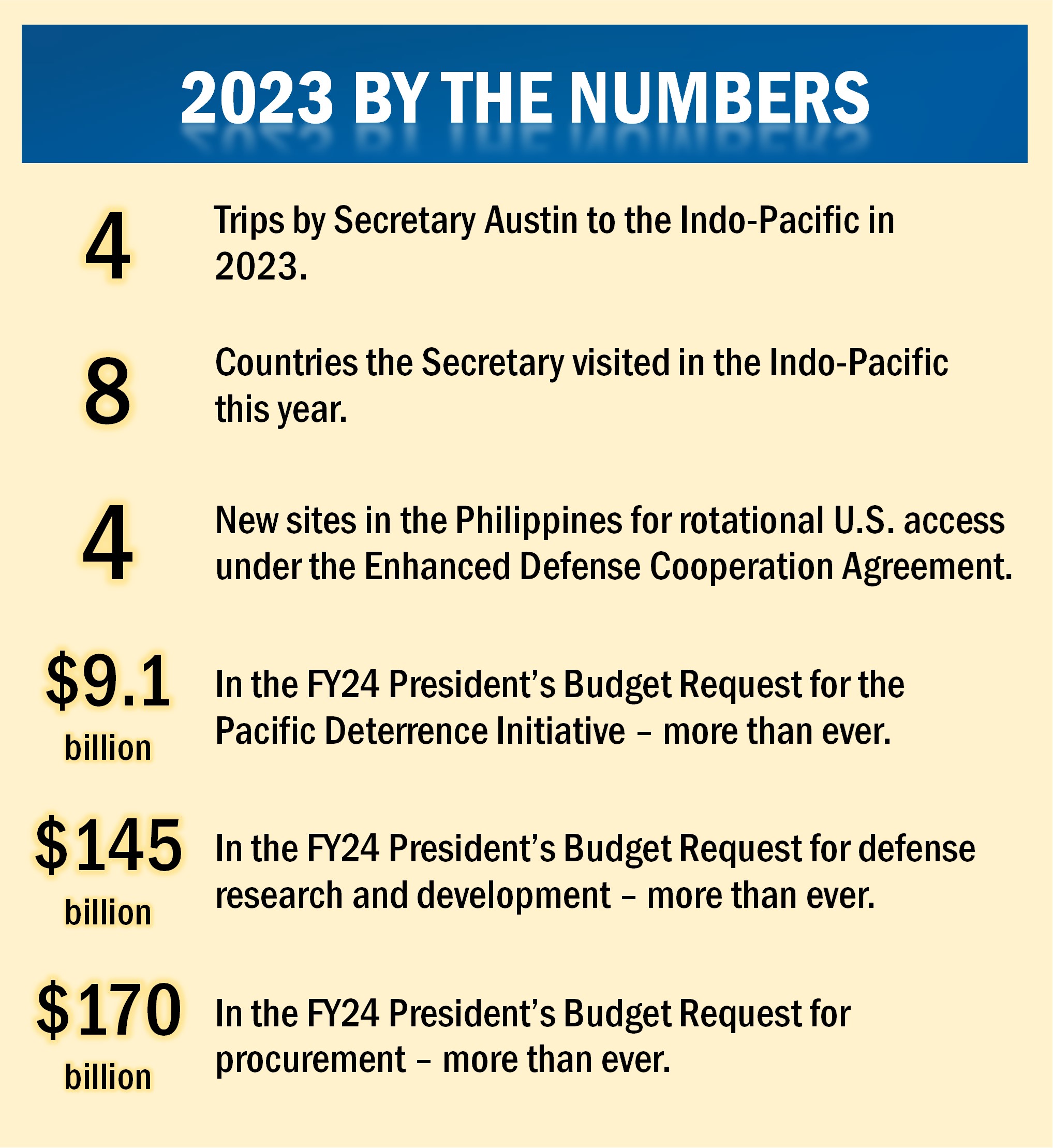Throughout 2023, the United States has worked alongside allies and partners to deliver groundbreaking achievements for peace, stability, and deterrence in support of a free and open Indo-Pacific region. As Secretary Austin has said, “In this decisive decade, 2023 will be remembered as a decisive year for implementing U.S. defense strategy in Asia.”
Transforming U.S. Regional Force Posture
In 2023, the United States delivered historic achievements with allies and partners to make U.S. force posture in the Indo-Pacific region more mobile, distributed, resilient, and lethal, including by:
- Forward stationing key U.S. military units to Japan, including a U.S. Marine Littoral Regiment – the Marine Corps' most advanced formation – and a U.S. Army watercraft unit to significantly enhance combat-credible deterrence.
- Launching a series of new force postures initiatives with Australia, including more and longer expeditionary visits of U.S. submarines resulting from AUKUS, increased rotations of U.S. bombers and fighters, expanded maritime and ground forces cooperation, enhanced space and logistics cooperation, continuing upgrades of key bases, and movement toward the creation of Submarine Rotational Force-West in Australia by 2027.
- Expanding U.S. rotational access across the Philippines by designating four new Enhanced Defense Cooperation Agreement (EDCA) sites at strategic locations, which will strengthen the interoperability of U.S. and Philippine armed forces and allow both countries to address shared challenges in the Indo-Pacific region.
- Concluding a Defense Cooperation Agreement with Papua New Guinea (PNG) that builds on decades of bilateral defense and security cooperation, strengthens the U.S.-PNG relationship, and increases regional stability and security.
- Bolstering deterrence and increasing strategic asset rotations to the Korean Peninsula, including the first port call of a U.S. SSBN to the Republic of Korea (ROK) in over 40 years and the first landing of a U.S. nuclear-capable B-52 on the Peninsula since 1988.

Making Historic Investments in Capability
The United States is deploying cutting-edge military capabilities right now, developing the capabilities needed to maintain deterrence in the Indo-Pacific in the future, and supporting allies and partners as they invest in their own capabilities by:
- Releasing the most strategy-driven defense budget in the Department's history, including $170 billion for procurement to advance air, sea, and land power; $145 billion for research, development, test, and evaluation; and $9.1 billion for the Pacific Deterrence Initiative – more than ever proposed for these key lines of effort.
- Announcing the Optimal Pathway for Australia to acquire conventionally-armed, nuclear-powered submarine capabilities through AUKUS.
- Supporting Japan’s decision to acquire new capabilities that strengthen regional deterrence, including indigenous and acquired counterstrike capabilities like the Tomahawk Land Attack Missile, as well as Tokyo’s decision to double its defense budget over the next five years and develop its research, testing, and industrial expertise to promote regional peace and stability.
- Advancing defense industrial base cooperation with Australia, including by agreeing to develop the ability to co-produce Guided Multiple Launch Rocket Systems (GMLRS) by 2025, announcing an AUKUS Innovation Challenge focused on electronic warfare, and launching a new Maritime Autonomy Experimentation and Exercise Series through AUKUS.
- Bolstering India's defense modernization plans, including by advancing the priorities outlined in the Roadmap for U.S.-India Defense Industrial Cooperation to co-produce fighter jet engines and Stryker armored vehicles, as well as launching the India-U.S. Defense Acceleration Ecosystem (INDUS-X) to promote partnerships between U.S. and Indian researchers, entrepreneurs, and investors.
Advancing a Shared Regional Vision
The United States is joining together with Indo-Pacific allies and partners in ways that strengthen peace and security across the region, including by operating together like never before. Key examples include:
- Japan and the ROK, cooperating more deeply than ever following this year’s historic Camp David Summit. In December, the three countries delivered on two key objectives from the summit – a multi-year, trilateral exercise plan and the full activation a real-time DPRK missile warning data-sharing mechanism.
- Australia and Japan, strengthening cooperation through participating in bilateral and trilateral exercises, and integrating Japan into existing U.S.-Australia force posture initiatives.
- India, modernizing the scope our military engagements including by incorporating advanced fighter aircraft and strategic bombers in our exercises, which strengthens interoperability and highlights shared efforts to promote stability and security in the Indo-Pacific.
- The Philippines, issuing the alliance’s first-ever Bilateral Defense Guidelines to chart a vision for defense cooperation across all domains.
- The Association of Southeast Asian Nations (ASEAN), including through capacity-building programs and training courses to support the incorporation of Women, Peace, and Security principles into regional security planning and operations, as well as an emerging leaders fellowship program for young civilian and defense leaders in the Indo-Pacific.
- Investing over $1.2 billion in security cooperation initiatives across the Indo-Pacific region, including one of the largest U.S. investments in history to bolster Indo-Pacific partners’ capability and capacity, maritime domain awareness, and resilience against coercion.
- Exercise BALIKATAN with the Philippines, which featured more than 17,600 service members from the Philippines, Australia, and the United States, and – for the first time ever – featured littoral live fire and cyber defense elements to support deeper interoperability.
- Exercise COPE THUNDER with the Philippines, which returned to the Philippines for the first time after more than thirty years, featuring participation by fifth-generation fighter jets.
- Exercise SUPER GARUDA SHIELD with Indonesia and over ten nations represented, which featured more than 4,000 service members participating in amphibious and airborne operations training, command and control simulation, academic exchanges, and professional development exercises.
- Exercise MALABAR with India, Japan, and Australia, hosted in Australia for the first time this year, which facilitated high-end training in anti-submarine exercises, communications, and air defense.
- Exercise PACIFIC VANGUARD with the ROK, Japan, and Australia, which strengthened interoperability at sea by bringing together over 2,000 naval forces from the United States and three of its closest allies.